Chilling Out or Heating Up: Investigating the Thermal Perception in Resting Areas of Small Urban Parks
Abstract
1. Introduction
- (1)
- How are park elements positioned around resting areas in small urban parks?
- (2)
- How does the placement of park elements, such as their orientation relative to resting areas and their proportions within a defined proximity, influence thermal perception?
| Reference | Park Number | Park Scale | Methods | PCI Presented By | City | Climate |
|---|---|---|---|---|---|---|
| [30] | 1 | 4.5 ha | Simulation (Envi-met) | Ta (Air temperature) | Chongqing | Hot and humid climate |
| [31] | 27 | 1–106 ha | In situ measurement | LST (Land surface temperature) | Melbourne | Temperate oceanic climate |
| [32] | 1 | 680 ha | In situ measurement | Ta | Beijing | Monsoon influenced humid continental climate |
| [8] | 10 | 15.2–285.3 ha | In situ measurement | Ta | Beijing | Monsoon influenced humid continental climate |
| [9] | 153 | 0.3–461.7 ha | Remote sensing | LST | Changsha | Subtropical monsoon climate |
| [33] | 1 | 2.0 ha | Simulation (CFD) | Ta | Ljubljana | Temperate oceanic climate |
| [34] | 1 | 14 ha | In situ measurement | Ta | Argentina | Arid continental climate |
| [35] | 8 | 0.3–7.7 ha | Remote sensing | LST | Granada | Mediterranean climate |
| [36] | 3 | 1.5–26 ha | In situ measurement | LST | Melbourne | Temperate oceanic climate |
| [37] | 1 | 355 ha | Simulation (Envi-met) | PET and Ta | Berlin | Temperate oceanic climate |
| [38] | 1 | 1.5 ha | In situ measurement | Ta | Melbourne | Temperate oceanic climate |
| [39] | 266 | 0.4–5654 ha | Remote sensing | LST | Beijing | Monsoon influenced humid continental climate |
| [40] | 7 locations on a university campus | / | In situ measurement and simulation (Envi-met) | Ta and MRT | Portland | Temperate oceanic climate |
2. Study Area and Methods
2.1. Study Area
2.2. On-Site Meteorological Measurement
2.3. Thermal Perception Evaluation
2.4. Spatial Analysis
2.5. Statistical Analysis
3. Results
3.1. Thermal Perception in the Resting Areas and Surrounding Open Areas
3.2. Spatial Relationship Between Park Elements and Resting Areas
3.3. Effects of Park Element Placement on Thermal Perception in Resting Areas
4. Discussion
4.1. Thermal Perception in the Resting Areas of Small Urban Parks
4.2. Suggestions for Small Urban Park Design for Thermal Comfort
- (1)
- Orientation and placement of shade elements:To block solar radiation effectively, shade elements should be placed to the west and south of resting areas. We also recommend placing shade elements and resting areas in proximity, ideally within a 5 m radius. While this may seem obvious, especially for artificial shelters like pavilions and roofs, as benches are typically placed beneath them, the alignment between trees and resting areas is often less consistent. For instance, in our study parks, nearly half of resting areas lacked effective shading, while some well-shaded spots under large tree canopies were left unused simply due to the absence of seating amenities.The sun’s position varies throughout the day, causing shifting shadow patterns. During the morning hours (9:00–11:00), when the sun was high in the southeast, shade elements to the south within a 5 m radius had a significant influence on thermal perception. Around midday (11:00–15:00), with the highest solar altitude, shade elements with sufficient horizontal spread became essential for providing effective shade. Accordingly, shade elements to the west and south within a 5 m radius showed the strongest mitigation effect. As the sun moved westward during this period, west-side shade elements within a 10 m radius still provided some shading, though less effectively than those positioned closer to the resting areas (Figure 8b). In the afternoon (15:00–17:00), as the sun lowered toward the west and shadows extended, west-oriented shade became more important while the required TR proportion decreased. Overall, close-proximity shade elements provide shading benefits in low-latitude summer conditions. In practice, the placement of shade elements can also be adjusted according to typical periods of use. For example, green spaces in busy districts require a more extensive and evenly distributed shade to support full-day use, whereas spaces primarily used for morning or evening exercises may be effectively shaded with a moderate amount of cover concentrated on the south or west.
- (2)
- Proportion of shade elements:The results indicate that positioning over 60% of shade elements to the west or south of resting areas, within a 5 m radius, can prevent those areas from becoming “hot” during peak daytime temperatures (11:00–15:00). For afternoon comfort (15:00–17:00), 30–40% shade elements are required. As morning thermal conditions are relatively cool, approximately 10% shade coverage to the south is sufficient. A study on Japanese gardens in Kyoto [12] suggest maintaining about 85% and 80% shade coverage within 5 and 10 m radii, respectively, to maintain a PET below 38 °C. These quantitative thresholds offer practical value for park designers and urban planners, enabling the creation of thermally comfortable rest spots in limited spaces using the minimum number of trees or shelters.Beyond hot and humid regions, the strategic placement of shade elements is also critical for summer thermal comfort in other warm climates. However, the optimal density and type of shade should be calibrated to local climatic conditions. For instance, evergreen trees provide continuous shading and are advantageous in regions with extended hot seasons, while deciduous trees can enhance seasonal comfort in temperate climates by offering shade in summer and allowing solar warming in winter. Therefore, while the design suggestions proposed in this study have broad applicability, vegetation selection and seasonal management should be tailored to regional climate characteristics.
- (3)
- Balancing shade and ventilation:In this study, the effects of trees and buildings (roofs) were primarily assessed through their contributions to shade provision. However, these elements may also influence thermal perception by blocking wind. A simulation study of urban canyons reported that higher green coverage ratios and denser tree canopies weaken airflow [57]. Similarly, in this study, the proportion of tree canopies and roofs located to the north within a 20 m radius (TR_N) was negatively associated with thermal perception (Figure 8b). Although this effect was not explicitly quantified in the present analysis, it should be further examined in future studies and carefully considered in practical park design.
- (4)
- Ground materials:The effect of green ground on thermal comfort has been found to be weak in many studies [17,58], including the present study. This is likely due to the small volumes of ground vegetation in small green spaces and inappropriate placement of green ground. Although small patches of green ground may not substantially improve thermal perception, increasing green ground coverage reduces pavement area, which is important because paved surfaces can intensify heat stress, especially under direct sunlight [17]. In this study, green ground was negatively correlated to thermal comfort (Figure 8a) because resting areas surrounded by a large proportion of green ground were often designed to be open with fewer trees. As this study examined only three parks, further research is needed to determine whether this pattern is widespread in park design. Nevertheless, unshaded green ground not only provides limited cooling but is also vulnerable to water stress under solar radiation, whereas shaded green ground can further enhance thermal comfort due to lower surface temperatures [58]. Similarly, both Cui and Shibata [12] and Cui et al. [24] suggest that green ground enhances thermal comfort when it is extensive and shaded. Taking these findings into account, along with the broader benefits of green ground, including habitat provision and flood mitigation, we recommend prioritizing green ground over pavement in urban parks, provided that effective shade is ensured during the hottest hours of the day.
4.3. Limitations
5. Conclusions
Supplementary Materials
Author Contributions
Funding
Data Availability Statement
Acknowledgments
Conflicts of Interest
Abbreviations
| PCI | Park cool islands |
| PET | Physiological equivalent temperature |
| UTCI | Universal thermal climate index |
| Ta | Air temperature |
| RH | Relative humidity |
| v | Wind velocity |
| Tg | Globe temperature |
| MRT | Mean radiant temperature |
References
- IPCC. Climate Change 2021: The Physical Science Basis. Contribution of Working Group I to the Sixth Assessment Report of the Intergovernmental Panel on Climate Change; IPCC: Geneva, Switzerland, 2021. [Google Scholar]
- Japan Meteorological Agency. Global Warming Projection Vol.9 (Dataset Interpretation); Japan Meteorological Agency: Tokyo, Japan, 2021.
- Waite, M.; Cohen, E.; Torbey, H.; Piccirilli, M.; Tian, Y.; Modi, V. Global Trends in Urban Electricity Demands for Cooling and Heating. Energy 2017, 127, 786–802. [Google Scholar] [CrossRef]
- International Energy Agency. The Future of Cooling; IEA: Paris, France, 2018; p. 92. [Google Scholar]
- Bernard, P.; Chevance, G.; Kingsbury, C.; Baillot, A.; Romain, A.-J.; Molinier, V.; Gadais, T.; Dancause, K.N. Climate Change, Physical Activity and Sport: A Systematic Review. Sports Med. 2021, 51, 1041–1059. [Google Scholar] [CrossRef]
- Vicedo-Cabrera, A.M.; Scovronick, N.; Sera, F.; Royé, D.; Schneider, R.; Tobias, A.; Astrom, C.; Guo, Y.; Honda, Y.; Hondula, D.M.; et al. The Burden of Heat-Related Mortality Attributable to Recent Human-Induced Climate Change. Nat. Clim. Change 2021, 11, 492–500. [Google Scholar] [CrossRef]
- Parks, R.M.; Bennett, J.E.; Tamura-Wicks, H.; Kontis, V.; Toumi, R.; Danaei, G.; Ezzati, M. Anomalously Warm Temperatures Are Associated with Increased Injury Deaths. Nat. Med. 2020, 26, 65–70. [Google Scholar] [CrossRef]
- Li, Y.; Fan, S.; Li, K.; Zhang, Y.; Kong, L.; Xie, Y.; Dong, L. Large Urban Parks Summertime Cool and Wet Island Intensity and Its Influencing Factors in Beijing, China. Urban For. Urban Green. 2021, 65, 127375. [Google Scholar] [CrossRef]
- Liao, W.; Guldmann, J.-M.; Hu, L.; Cao, Q.; Gan, D.; Li, X. Linking Urban Park Cool Island Effects to the Landscape Patterns inside and Outside the Park: A Simultaneous Equation Modeling Approach. Landsc. Urban Plan. 2023, 232, 104681. [Google Scholar] [CrossRef]
- Chang, C.-R.; Li, M.-H.; Chang, S.-D. A Preliminary Study on the Local Cool-Island Intensity of Taipei City Parks. Landsc. Urban Plan. 2007, 80, 386–395. [Google Scholar] [CrossRef]
- Rupprecht, C.D.D.; Cui, L. Understanding Threats to Young Children’s Green Space Access in Unlicensed Daycare Centers in Japan. Int. J. Environ. Res. Public Health 2020, 17, 1948. [Google Scholar] [CrossRef] [PubMed]
- Cui, L.; Shibata, S. Exploring Climate-Adaptive Green-Space Designs for Hot and Humid Climates: Lessons from Japanese Dry Gardens. Urban For. Urban Green. 2024, 93, 128207. [Google Scholar] [CrossRef]
- Hwang, Y.H.; Lum, Q.J.G.; Chan, Y.K.D. Micro-Scale Thermal Performance of Tropical Urban Parks in Singapore. Build. Environ. 2015, 94, 467–476. [Google Scholar] [CrossRef]
- Lin, T.-P.; Tsai, K.-T.; Liao, C.-C.; Huang, Y.-C. Effects of Thermal Comfort and Adaptation on Park Attendance Regarding Different Shading Levels and Activity Types. Build. Environ. 2013, 59, 599–611. [Google Scholar] [CrossRef]
- Martinelli, L.; Lin, T.-P.; Matzarakis, A. Assessment of the Influence of Daily Shadings Pattern on Human Thermal Comfort and Attendance in Rome during Summer Period. Build. Environ. 2015, 92, 30–38. [Google Scholar] [CrossRef]
- Watanabe, S.; Ishii, J. Effect of Outdoor Thermal Environment on Pedestrians’ Behavior Selecting a Shaded Area in a Humid Subtropical Region. Build. Environ. 2016, 95, 32–41. [Google Scholar] [CrossRef]
- Cheung, P.K.; Jim, C.Y. Differential Cooling Effects of Landscape Parameters in Humid-Subtropical Urban Parks. Landsc. Urban Plan. 2019, 192, 103651. [Google Scholar] [CrossRef]
- Lachapelle, J.A.; Scott Krayenhoff, E.; Middel, A.; Coseo, P.; Warland, J. Maximizing the Pedestrian Radiative Cooling Benefit per Street Tree. Landsc. Urban Plan. 2023, 230, 104608. [Google Scholar] [CrossRef]
- Middel, A.; Krayenhoff, E.S. Micrometeorological Determinants of Pedestrian Thermal Exposure during Record-Breaking Heat in Tempe, Arizona: Introducing the MaRTy Observational Platform. Sci. Total Environ. 2019, 687, 137–151. [Google Scholar] [CrossRef] [PubMed]
- Bowler, D.E.; Buyung-Ali, L.; Knight, T.M.; Pullin, A.S. Urban Greening to Cool Towns and Cities: A Systematic Review of the Empirical Evidence. Landsc. Urban Plan. 2010, 97, 147–155. [Google Scholar] [CrossRef]
- Armson, D.; Stringer, P.; Ennos, A.R. The Effect of Tree Shade and Grass on Surface and Globe Temperatures in an Urban Area. Urban For. Urban Green. 2012, 11, 245–255. [Google Scholar] [CrossRef]
- Liu, S.; Zhao, J.; Xu, M.; Ahmadian, E. Effects of Landscape Patterns on the Summer Microclimate and Human Comfort in Urban Squares in China. Sustain. Cities Soc. 2021, 73, 103099. [Google Scholar] [CrossRef]
- Amani-Beni, M.; Zhang, B.; Xie, G.; Xu, J. Impact of Urban Park’s Tree, Grass and Waterbody on Microclimate in Hot Summer Days: A Case Study of Olympic Park in Beijing, China. Urban For. Urban Green. 2018, 32, 1–6. [Google Scholar] [CrossRef]
- Cui, L.; Rupprecht, C.D.D.; Shibata, S. Climate-Responsive Green-Space Design Inspired by Traditional Gardens: Microclimate and Human Thermal Comfort of Japanese Gardens. Sustainability 2021, 13, 2736. [Google Scholar] [CrossRef]
- Ng, E.; Chen, L.; Wang, Y.; Yuan, C. A Study on the Cooling Effects of Greening in a High-Density City: An Experience from Hong Kong. Build. Environ. 2012, 47, 256–271. [Google Scholar] [CrossRef]
- Gillner, S.; Vogt, J.; Tharang, A.; Dettmann, S.; Roloff, A. Role of Street Trees in Mitigating Effects of Heat and Drought at Highly Sealed Urban Sites. Landsc. Urban Plan. 2015, 143, 33–42. [Google Scholar] [CrossRef]
- Lee, H.; Mayer, H.; Chen, L. Contribution of Trees and Grasslands to the Mitigation of Human Heat Stress in a Residential District of Freiburg, Southwest Germany. Landsc. Urban Plan. 2016, 148, 37–50. [Google Scholar] [CrossRef]
- Cheung, P.K.; Jim, C.Y.; Tapper, N.; Nice, K.A.; Livesley, S.J. Daytime Irrigation Leads to Significantly Cooler Private Backyards in Summer. Urban Clim. 2022, 46, 101310. [Google Scholar] [CrossRef]
- Shashua-Bar, L.; Pearlmutter, D.; Erell, E. The Influence of Trees and Grass on Outdoor Thermal Comfort in a Hot-Arid Environment. Int. J. Climatol. 2011, 31, 1498–1506. [Google Scholar] [CrossRef]
- Lu, J.; Li, Q.; Zeng, L.; Chen, J.; Liu, G.; Li, Y.; Li, W.; Huang, K. A Micro-Climatic Study on Cooling Effect of an Urban Park in a Hot and Humid Climate. Sustain. Cities Soc. 2017, 32, 513–522. [Google Scholar] [CrossRef]
- Algretawee, H.; Rayburg, S.; Neave, M. Estimating the Effect of Park Proximity to the Central of Melbourne City on Urban Heat Island (UHI) Relative to Land Surface Temperature (LST). Ecol. Eng. 2019, 138, 374–390. [Google Scholar] [CrossRef]
- Yan, H.; Wu, F.; Dong, L. Influence of a Large Urban Park on the Local Urban Thermal Environment. Sci. Total Environ. 2018, 622–623, 882–891. [Google Scholar] [CrossRef] [PubMed]
- Vidrih, B.; Medved, S. Multiparametric Model of Urban Park Cooling Island. Urban For. Urban Green. 2013, 12, 220–229. [Google Scholar] [CrossRef]
- RUIZ, M.A.; COLLI, M.F.; MARTINEZ, C.F.; CORREA-CANTALOUBE, E.N. Park Cool Island and Built Environment. A Ten-Year Evaluation in Parque Central, Mendoza-Argentina. Sustain. Cities Soc. 2022, 79, 103681. [Google Scholar] [CrossRef]
- García, D.H. Spatio-Temporal Analysis of the Urban Green Infrastructure of the City of Granada (Spain) as a Heat Mitigation Measure Using High-Resolution Images Sentinel 3. Urban For. Urban Green. 2023, 87, 128061. [Google Scholar] [CrossRef]
- Algretawee, H. The Effect of Graduated Urban Park Size on Park Cooling Island and Distance Relative to Land Surface Temperature (LST). Urban Clim. 2022, 45, 101255. [Google Scholar] [CrossRef]
- Sodoudi, S.; Zhang, H.; Chi, X.; Müller, F.; Li, H. The Influence of Spatial Configuration of Green Areas on Microclimate and Thermal Comfort. Urban For. Urban Green. 2018, 34, 85–96. [Google Scholar] [CrossRef]
- Motazedian, A.; Coutts, A.M.; Tapper, N.J. The Microclimatic Interaction of a Small Urban Park in Central Melbourne with Its Surrounding Urban Environment during Heat Events. Urban For. Urban Green. 2020, 52, 126688. [Google Scholar] [CrossRef]
- Qiu, K.; Jia, B. The Roles of Landscape Both inside the Park and the Surroundings in Park Cooling Effect. Sustain. Cities Soc. 2020, 52, 101864. [Google Scholar] [CrossRef]
- Taleghani, M.; Sailor, D.J.; Tenpierik, M.; Dobbelsteen, A. van den Thermal Assessment of Heat Mitigation Strategies: The Case of Portland State University, Oregon, USA. Build. Environ. 2014, 73, 138–150. [Google Scholar] [CrossRef]
- Japan Meteorological Agency Annual Climate Report (Observations from 1991 to 2020). Available online: https://www.jma.go.jp/jma/press/2103/24a/210324_heinenchi.html (accessed on 25 July 2023).
- Kyoto City Kyoto City Statistics Portal/Montly Report. Available online: https://www2.city.kyoto.lg.jp/sogo/toukei/Publish/Monthly/ (accessed on 21 May 2023).
- Kyoto City Official Website Urban Parks in Kyoto City. Available online: https://www.city.kyoto.lg.jp/kensetu/page/0000214383.html (accessed on 21 May 2023).
- Höppe, P. The Physiological Equivalent Temperature—A Universal Index for the Biometeorological Assessment of the Thermal Environment. Int. J. Biometeorol. 1999, 43, 71–75. [Google Scholar] [CrossRef]
- Binarti, F.; Koerniawan, M.D.; Triyadi, S.; Utami, S.S.; Matzarakis, A. A Review of Outdoor Thermal Comfort Indices and Neutral Ranges for Hot-Humid Regions. Urban Clim. 2020, 31, 100531. [Google Scholar] [CrossRef]
- Matzarakis, A.; Rutz, F.; Mayer, H. Modelling Radiation Fluxes in Simple and Complex Environments—Application of the RayMan Model. Int. J. Biometeorol. 2007, 51, 323–334. [Google Scholar] [CrossRef]
- Matzarakis, A.; Mayer, H. Another Kind of Environmental Stress: Thermal Stress. WHO Newsl. 1996, 18, 7–10. [Google Scholar]
- Lin, T.P.; Matzarakis, A. Tourism Climate and Thermal Comfort in Sun Moon Lake, Taiwan. Int. J. Biometeorol. 2008, 52, 281–290. [Google Scholar] [CrossRef]
- Ouyang, W.; Liu, Z.; Lau, K.; Shi, Y.; Ng, E. Comparing Different Recalibrated Methods for Estimating Mean Radiant Temperature in Outdoor Environment. Build. Environ. 2022, 216, 109004. [Google Scholar] [CrossRef]
- Chen, L.; Ng, E. Outdoor Thermal Comfort and Outdoor Activities: A Review of Research in the Past Decade. Cities 2012, 29, 118–125. [Google Scholar] [CrossRef]
- Lee, L.S.H.; Cheung, P.K.; Fung, C.K.W.; Jim, C.Y. Improving Street Walkability: Biometeorological Assessment of Artificial-Partial Shade Structures in Summer Sunny Conditions. Int. J. Biometeorol. 2020, 64, 547–560. [Google Scholar] [CrossRef] [PubMed]
- Thorsson, S.; Honjo, T.; Lindberg, F.; Eliasson, I.; Lim, E.-M. Thermal Comfort and Outdoor Activity in Japanese Urban Public Places. Environ. Behav. 2007, 39, 660–684. [Google Scholar] [CrossRef]
- Kántor, N.; Chen, L.; Gál, C.V. Human-Biometeorological Significance of Shading in Urban Public Spaces—Summertime Measurements in Pécs, Hungary. Landsc. Urban Plan. 2018, 170, 241–255. [Google Scholar] [CrossRef]
- Watanabe, S.; Nagano, K.; Ishii, J.; Horikoshi, T. Evaluation of Outdoor Thermal Comfort in Sunlight, Building Shade, and Pergola Shade during Summer in a Humid Subtropical Region. Build. Environ. 2014, 82, 556–565. [Google Scholar] [CrossRef]
- Johansson, E.; Emmanuel, R. The Influence of Urban Design on Outdoor Thermal Comfort in the Hot, Humid City of Colombo, Sri Lanka. Int. J. Biometeorol. 2006, 51, 119–133. Available online: https://link.springer.com/article/10.1007/s00484-006-0047-6 (accessed on 27 October 2025).
- Ma, X.; Leung, T.M.; Chau, C.K.; Yung, E.H.K. Analyzing the Influence of Urban Morphological Features on Pedestrian Thermal Comfort. Urban Clim. 2022, 44, 101192. [Google Scholar] [CrossRef]
- Yuan, C.; Norford, L.; Ng, E. A Semi-Empirical Model for the Effect of Trees on the Urban Wind Environment. Landsc. Urban Plan. 2017, 168, 84–93. [Google Scholar] [CrossRef]
- Shashua-Bar, L.; Pearlmutter, D.; Erell, E. The Cooling Efficiency of Urban Landscape Strategies in a Hot Dry Climate. Landsc. Urban Plan. 2009, 92, 179–186. [Google Scholar] [CrossRef]
- Yang, W.; Wong, N.H.; Zhang, G. A Comparative Analysis of Human Thermal Conditions in Outdoor Urban Spaces in the Summer Season in Singapore and Changsha, China. Int. J. Biometeorol. 2013, 57, 895–907. [Google Scholar] [CrossRef]
- Enssle, F.; Kabisch, N. Urban Green Spaces for the Social Interaction, Health and Well-Being of Older People— An Integrated View of Urban Ecosystem Services and Socio-Environmental Justice. Environ. Sci. Policy 2020, 109, 36–44. [Google Scholar] [CrossRef]
- Ottoni, C.A.; Sims-Gould, J.; Winters, M.; Heijnen, M.; McKay, H.A. “Benches Become like Porches”: Built and Social Environment Influences on Older Adults’ Experiences of Mobility and Well-Being. Soc. Sci. Med. 2016, 169, 33–41. [Google Scholar] [CrossRef]
- Statistics Bureau of Japan Statistics Bureau Home Page/Statistical Handbook of Japan 2022. Available online: https://www.stat.go.jp/english/data/handbook/c0117.html (accessed on 11 May 2023).
- Kántor, N.; Unger, J. Benefits and Opportunities of Adopting GIS in Thermal Comfort Studies in Resting Places: An Urban Park as an Example. Landsc. Urban Plan. 2010, 98, 36–46. [Google Scholar] [CrossRef]

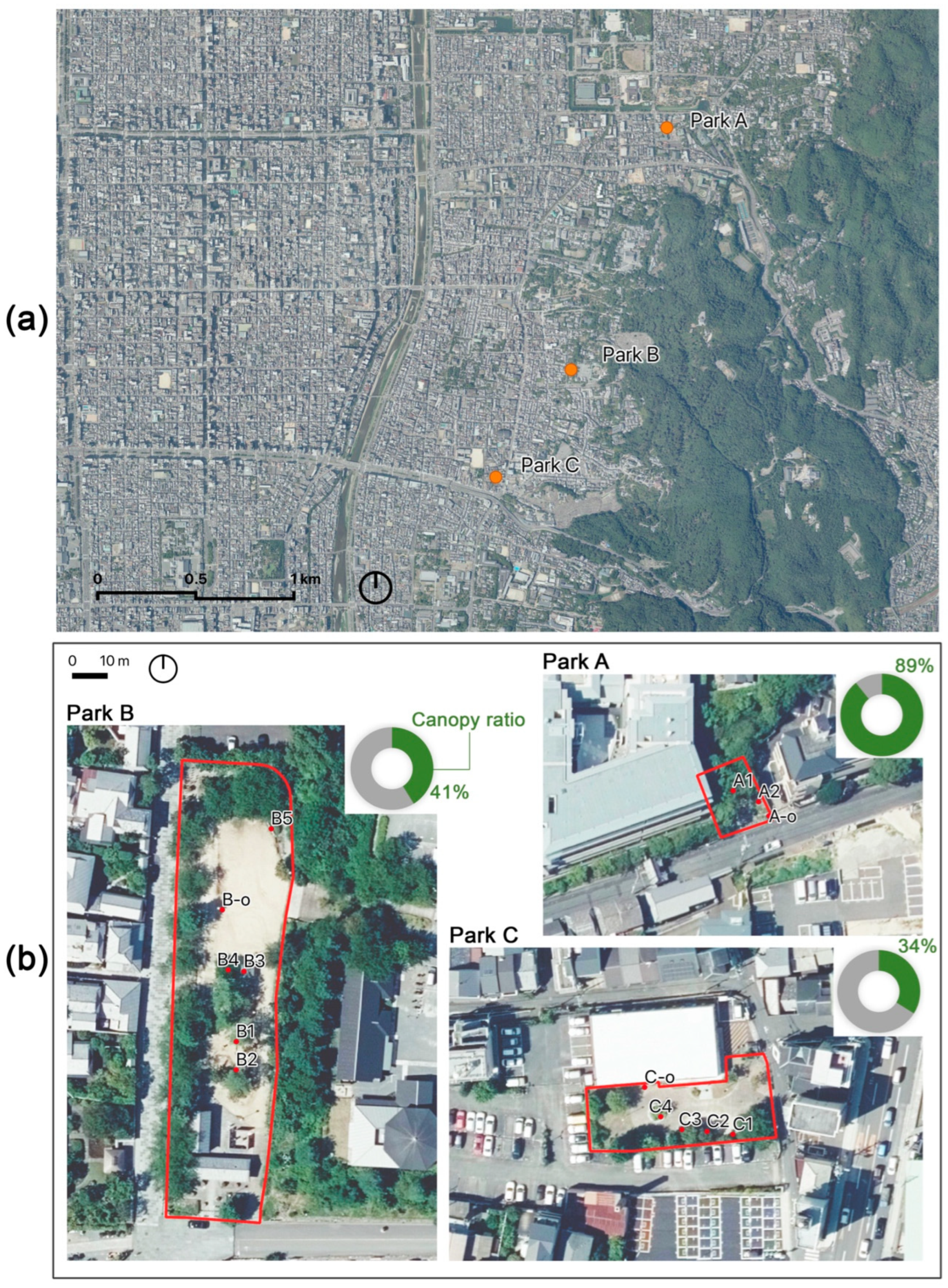
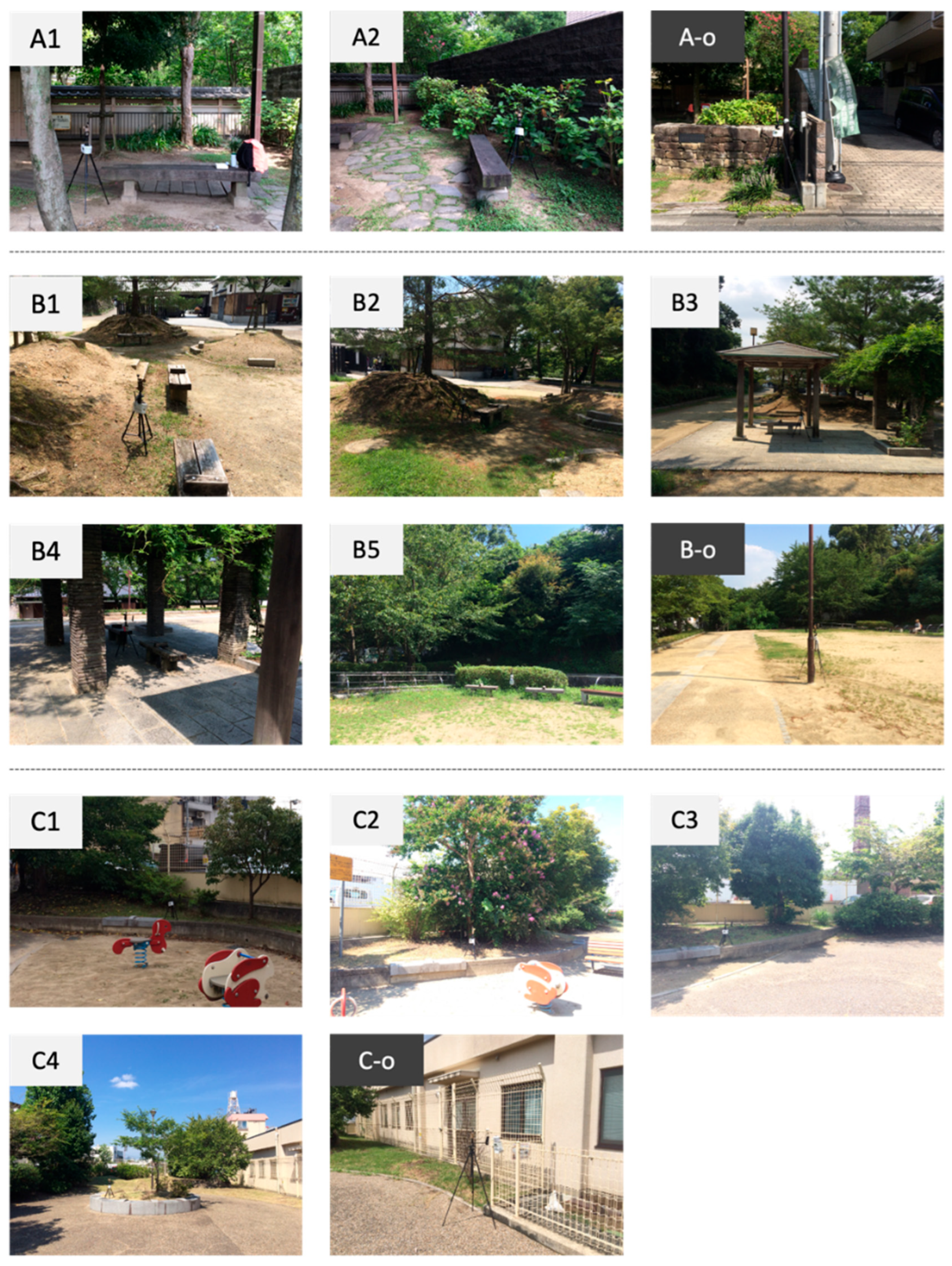

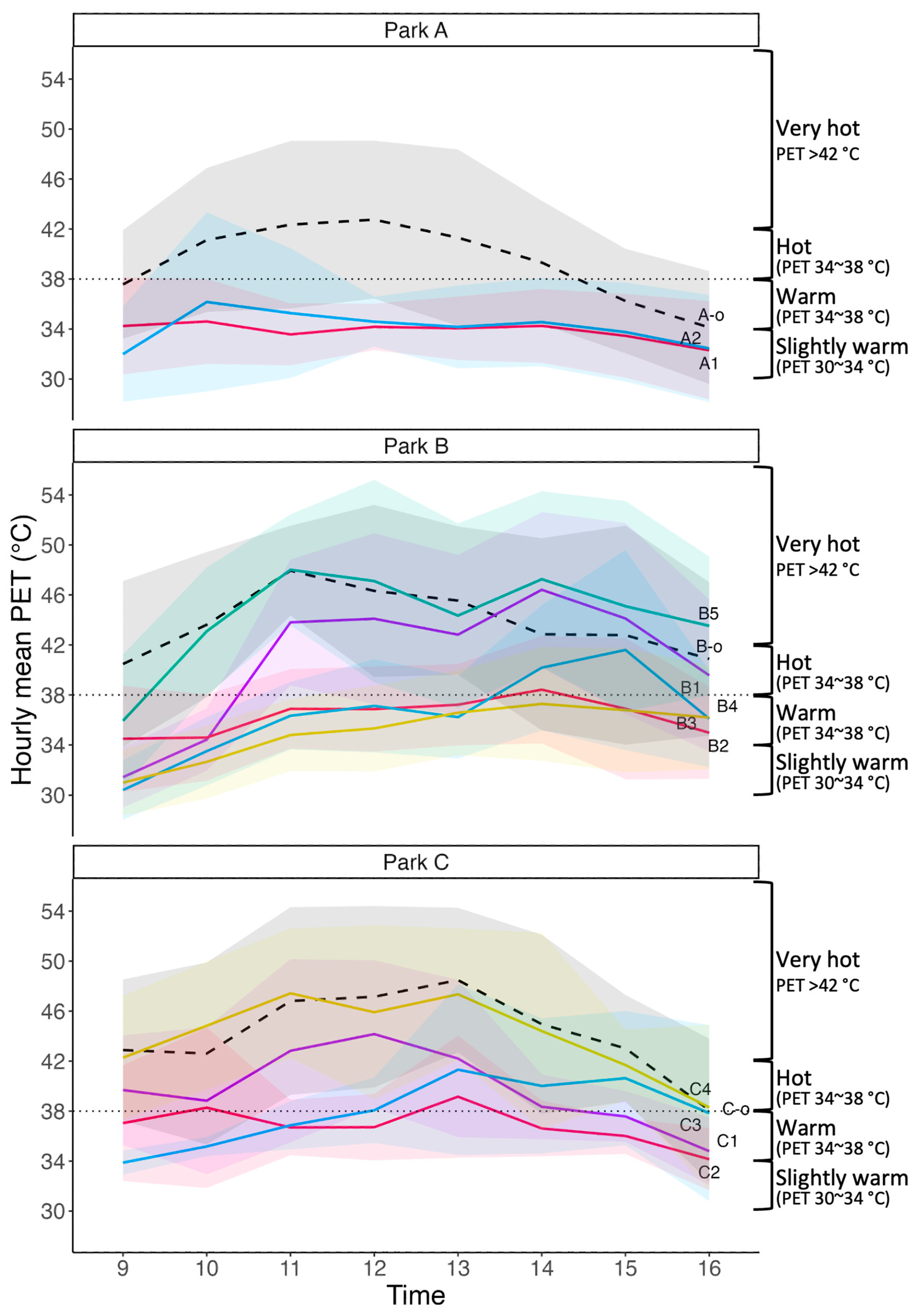
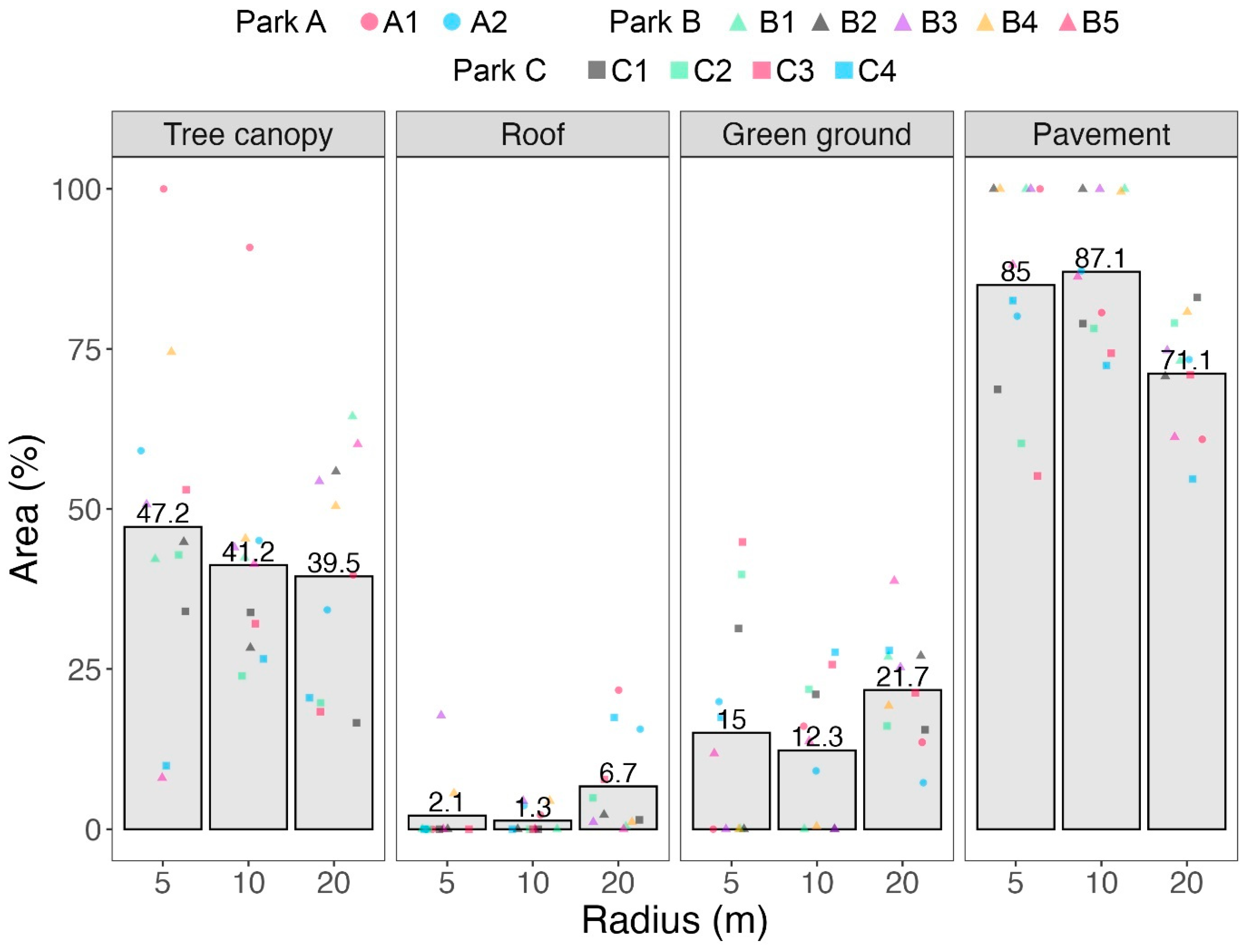
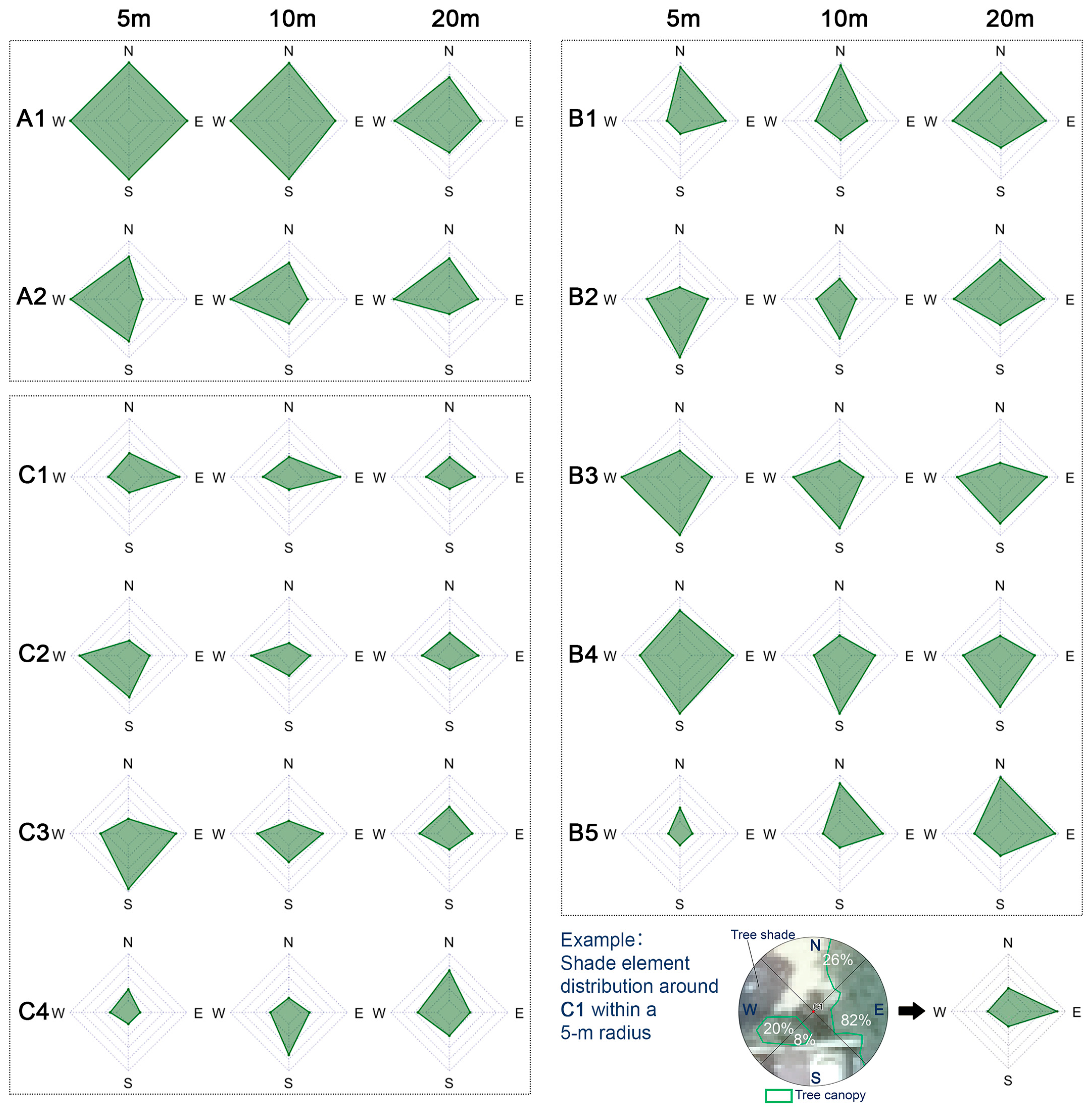
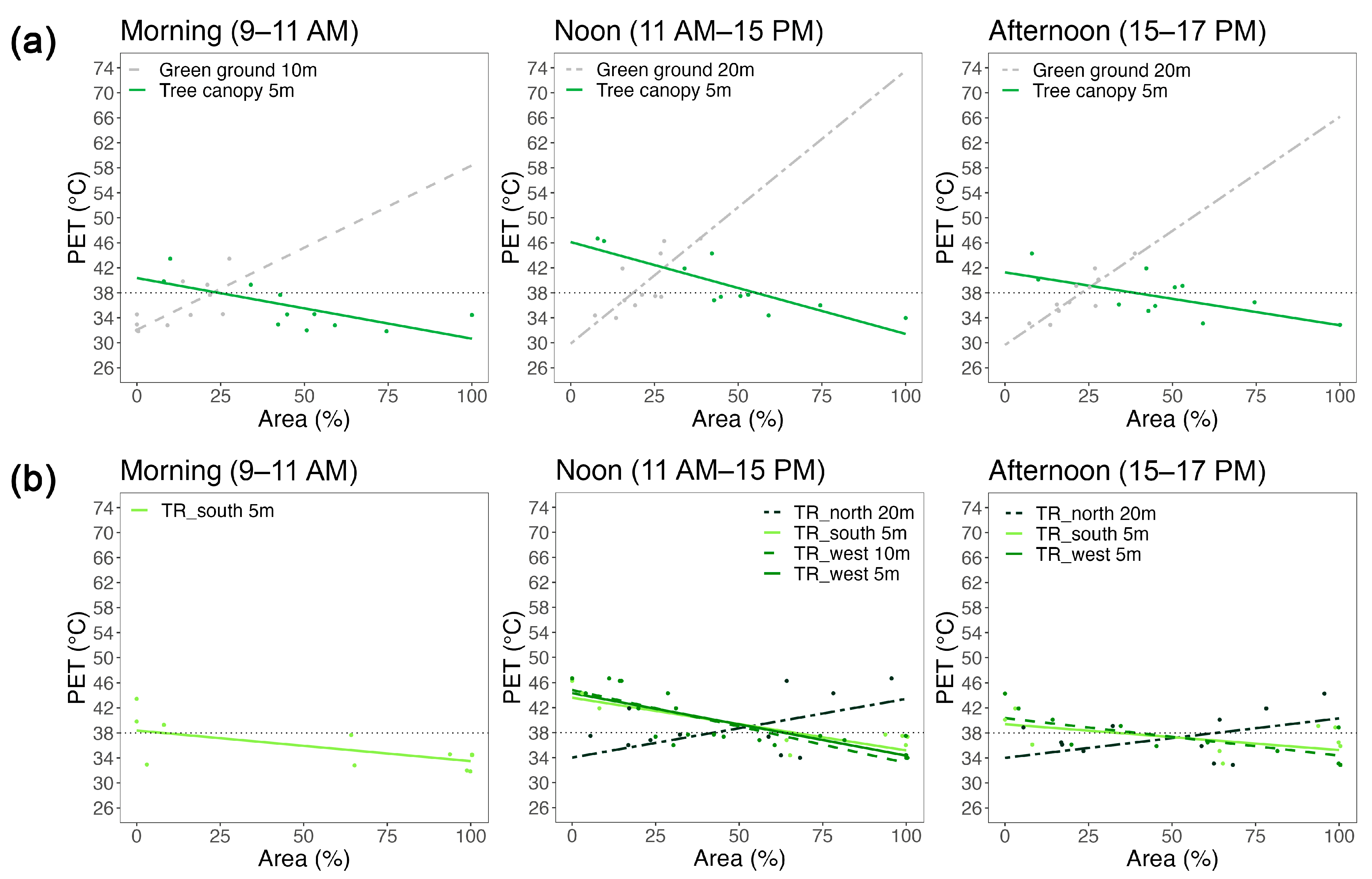
| Park A | Park B | Park C | |
|---|---|---|---|
| Construction year | 2004 | 1998 | 2006 |
| Area (m2) | 192 | 3120 | 703 |
| Park-wide tree canopy cover (%) | 89 | 41 | 34 |
| Dominant arbor tree species | Quercus glauca Acer palmatum | Pinus densiflora, Cerasus × yedoensis | Cerasus × yedoensis, Acer palmatum |
| Number of resting areas within the park | 2 benches | 3 benches 1 pavilion 1 wisteria trellis | 4 benches |
| Central/Western Europe (°C) [47] | Central Taiwan (°C) [48] | Thermal Perception |
|---|---|---|
| 8~13 | 18~22 | Cool |
| 13~18 | 22~26 | Slightly cool |
| 18~23 | 26~30 | Comfortable |
| 23~29 | 30~34 | Slightly warm |
| 29~35 | 34~38 | Warm |
| 35~41 | 38~42 | Hot |
| >41 | >42 | Very hot |
| Garden Elements | Definition |
|---|---|
| Tree canopy | Tree canopy at a height of 3 m or more |
| Roof | Roofs of pavilions and buildings |
| Green ground | Ground surface materials, including moss, grass, and shrubs, that are less than 3 m in height |
| Pavement | Paving materials, including concrete, asphalt, stone, gravel, and soil |
| Tree canopy and roof (TR) | The area that is covered either by tree canopies or roofs |
Disclaimer/Publisher’s Note: The statements, opinions and data contained in all publications are solely those of the individual author(s) and contributor(s) and not of MDPI and/or the editor(s). MDPI and/or the editor(s) disclaim responsibility for any injury to people or property resulting from any ideas, methods, instructions or products referred to in the content. |
© 2025 by the authors. Licensee MDPI, Basel, Switzerland. This article is an open access article distributed under the terms and conditions of the Creative Commons Attribution (CC BY) license (https://creativecommons.org/licenses/by/4.0/).
Share and Cite
Cui, L.; Shibata, S. Chilling Out or Heating Up: Investigating the Thermal Perception in Resting Areas of Small Urban Parks. Climate 2025, 13, 234. https://doi.org/10.3390/cli13110234
Cui L, Shibata S. Chilling Out or Heating Up: Investigating the Thermal Perception in Resting Areas of Small Urban Parks. Climate. 2025; 13(11):234. https://doi.org/10.3390/cli13110234
Chicago/Turabian StyleCui, Lihua, and Shozo Shibata. 2025. "Chilling Out or Heating Up: Investigating the Thermal Perception in Resting Areas of Small Urban Parks" Climate 13, no. 11: 234. https://doi.org/10.3390/cli13110234
APA StyleCui, L., & Shibata, S. (2025). Chilling Out or Heating Up: Investigating the Thermal Perception in Resting Areas of Small Urban Parks. Climate, 13(11), 234. https://doi.org/10.3390/cli13110234






